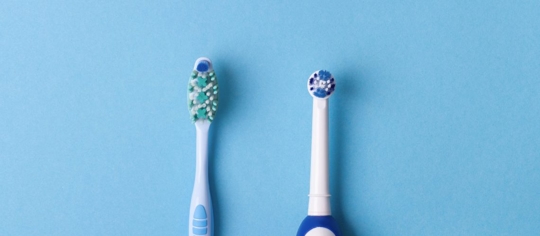During your twice-yearly dental cleaning appointment, your hygienist will customize a daily homecare routine for you and suggest products that he or she believes will most benefit you. Daily oral hygiene always includes brushing and flossing; the use of an oral rinse or mouthwash could also be encouraged if necessary. Personal daily oral hygiene requires the following sequence of procedures at least twice daily: Use dental floss first to remove plaque (bacteria) from between the teeth, toothbrushing following flossing to remove adhering plaque from tooth surfaces. Brushing and flossing are essential in the removal of the harmful bacteria that cause dental decay and periodontal disease (gum disease).
Toothbrushes fall into two main categories– manual or electric. Manual toothbrushes are hand-activated. All motion and power are created by the movement of the brush with your hand. While manual brushes are an acceptable way to remove plaque, bacteria, and debris from the oral cavity, they are not the most efficient. Without proper technique and adequate time, patients struggle to remove all bacteria and debris from their oral cavity. Electric toothbrushes take the guesswork out of toothbrushing. Electric or power toothbrushes move at speeds and motions that cannot be duplicated by manual brushes.
Electric toothbrushes operate at varying speeds (10,000-40,000 RPMs) depending on the manufacturer and type of brush. Brushes also come with a variety of brush head movements. “Rotating oscillating action toothbrushes are the most effective powered toothbrushes for reducing plaque and gingivitis” (Wilkins). Electric toothbrushes have enough power to do all the work of brushing themselves. When using an electric brush, it is important to follow your hygienist’s recommendations for brushing methods. Improper use of an electric brush does have some adverse effects. Using too much pressure or movement can contribute to gum recession. Fortunately, most electric brushes have built-in sensors to let you know when you are brushing too hard. Just like manual brushing, electric brushing should be performed for a minimum of two minutes, two times per day. Most electric brushes come pre-programmed with a timer!
How to properly use an electric toothbrush –
- Place brush on a tooth with a 45-degree angle TOWARDS the gum tissue
- Gently and slowly move the brush along the tooth surface
- Repeat this method for all tooth surfaces (cheek-side, tongue-side, and chewing surface)
- Allow the brush to complete a timed cycle before stopping

